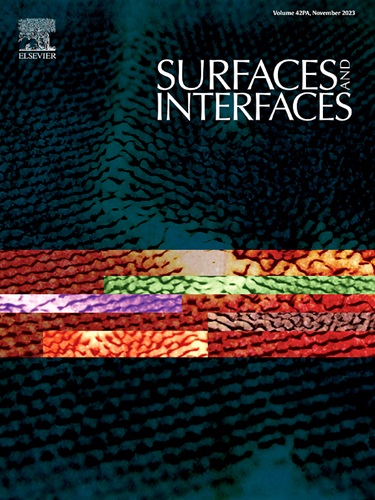Chain-length-dependent nanostructure evolution in InOx/PAM composite films: Interface engineering for electrical performance modulation
IF 6.3
2区 材料科学
Q2 CHEMISTRY, PHYSICAL
引用次数: 0
Abstract
The advancement of flexible electronics demands composite semiconductors that harmonize mechanical adaptability and electrical performance. This study elucidates how polyacrylamide (PAM) molecular weight governs nanocrystal evolution in InOx/PAM composite films through interfacial coordination dynamics and steric hindrance effects. Increasing PAM molecular weight drives nanocrystal morphology transitions from isotropic spherical clusters (short-chain) to anisotropic strip-like domains (medium-chain), and ultimately to highly dispersed isolated states (long-chain). Simultaneously, PAM modulates the connectivity of metal-oxygen-metal (M-O-M) networks while introducing defect states, establishing a dynamic equilibrium between carrier transport enhancement and defect-mediated scattering. Optimization of molecular weight (150000) and polymer doping concentration (1 wt %) enabled synergistic regulation of nanocrystal interconnectivity and defect generation, achieving 90 % mobility retention of pure InOx-TFTs (1.43 cm2/V.s) in InOx/PAM-TFTs (1.38 cm2/V.s). Notably, chain-length-dependent nanocrystal morphology governs carrier transport pathways: strip-like domains facilitate directional percolation, whereas dispersed nanocrystals exacerbate interfacial scattering. This work establishes a chain-length-engineered interface strategy for solution-processed composites, providing universal design principles for balancing crystallinity control and defect generation in next-generation flexible electronics.

链长度依赖的纳米结构演变在InOx/PAM复合薄膜:界面工程的电性能调制
柔性电子技术的进步要求复合半导体能够协调机械适应性和电气性能。本研究阐明了聚丙烯酰胺(PAM)分子量如何通过界面配位动力学和位阻效应影响InOx/PAM复合膜的纳米晶演化。随着PAM分子量的增加,纳米晶体形态从各向同性球形团簇(短链)转变为各向异性条状畴(中链),最终转变为高度分散的孤立态(长链)。同时,PAM在引入缺陷态的同时调节了金属-氧-金属(M-O-M)网络的连通性,在载流子输运增强和缺陷介导的散射之间建立了动态平衡。优化分子量(150000)和聚合物掺杂浓度(1wt %),可以协同调节纳米晶体的互连性和缺陷的产生,在InOx/PAM-TFTs (1.38 cm2/V.s)中实现90%的迁移率保持(1.43 cm2/V.s)。值得注意的是,链长相关的纳米晶体形态控制着载流子的传输途径:条形畴促进定向渗透,而分散的纳米晶体加剧了界面散射。这项工作为溶液加工复合材料建立了一种链长工程界面策略,为下一代柔性电子产品中平衡结晶度控制和缺陷产生提供了通用设计原则。
本文章由计算机程序翻译,如有差异,请以英文原文为准。
求助全文
约1分钟内获得全文
求助全文
来源期刊

Surfaces and Interfaces
Chemistry-General Chemistry
CiteScore
8.50
自引率
6.50%
发文量
753
审稿时长
35 days
期刊介绍:
The aim of the journal is to provide a respectful outlet for ''sound science'' papers in all research areas on surfaces and interfaces. We define sound science papers as papers that describe new and well-executed research, but that do not necessarily provide brand new insights or are merely a description of research results.
Surfaces and Interfaces publishes research papers in all fields of surface science which may not always find the right home on first submission to our Elsevier sister journals (Applied Surface, Surface and Coatings Technology, Thin Solid Films)
 求助内容:
求助内容: 应助结果提醒方式:
应助结果提醒方式:


